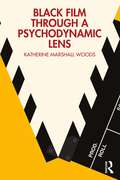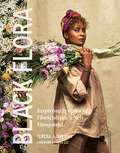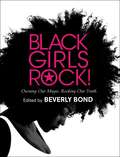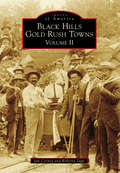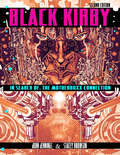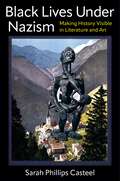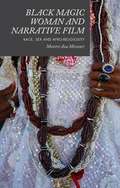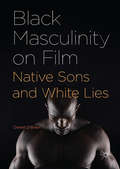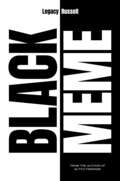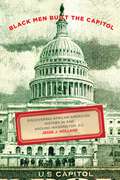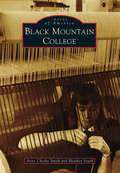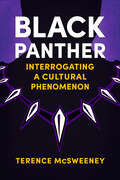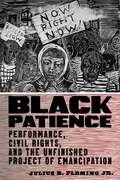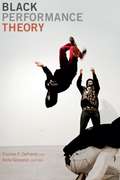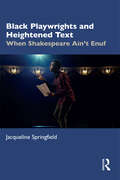- Table View
- List View
Black Film Through a Psychodynamic Lens
by Katherine Marshall WoodsBlack Film Through a Psychodynamic Lens delves into the nuanced character development and narrative themes within the struggles and successes presented in Black films over the last five decades.In this pioneering book, Katherine Marshall Woods looks at Black cinema from a psychological and psychoanalytic perspective. Focusing on a decade at a time, she charts the development of representation and creative output from the 1980s to the present day. She deftly moves from analyzing depictions of poverty and triumphs to highlighting the importance of cinema in shaping cultural identity while considering racial prejudice and discrimination. Adopting theoretical viewpoints from Freud to bell hooks, Marshall Woods examines the damaging effect on cultural psychology as a result of stereotypical racial tropes, and expertly demonstrates the healing that can be found when one sees oneself represented in an honest light in popular art.From Do The Right Thing, The Color Purple and Malcolm X to contemporary classics like 12 Years a Slave, Black Panther and American Fiction, this book is an essential read for those interested in the intersection between Psychology, Psychoanalysis, Film Theory, and African American cultural identity.
Black Flora: Inspiring Profiles of Floriculture's New Vanguard
by Teresa J. SpeightDiscover the growing community of Black floriculture leading the new vanguard in flowers.Black Flora is the first book to feature profiles of contemporary Black experts innovating in the world of flowers. Author and longtime gardener, Teresa Speight, offers a beautiful intersection of flowers and community. This book is a homecoming, one that unearths the floral legacies of the past and present, while providing a source of inspiration for younger generations of plant-lovers seeking examples of successful Black floral artists and entrepreneurs. With photos and insights from over 20 growers, florists, and designers from around the US, each with a deep reverence for nature, Black Flora showcases a range of floral expertise. And as visionary horticulturalist and garden historian, Abra Lee, reflects in her foreword, the community represented in Black Flora has an important significance both today, and in garden history. Both a celebration of now and a vision for the future, Black Flora honors floriculture&’s creative vanguard.
Black Futures
by Kimberly Drew Jenna WorthamAn archive of collective memory and exuberant testimonyA luminous map to navigate an opaque and disorienting presentAn infinite geography of possible futures What does it mean to be Black and alive right now?Kimberly Drew and Jenna Wortham have brought together this collection of work—images, photos, essays, memes, dialogues, recipes, tweets, poetry, and more—to tell the story of the radical, imaginative, provocative, and gorgeous world that Black creators are bringing forth today. The book presents a succession of startling and beautiful pieces that generate an entrancing rhythm: Readers will go from conversations with activists and academics to memes and Instagram posts, from powerful essays to dazzling paintings and insightful infographics. In answering the question of what it means to be Black and alive, Black Futures opens a prismatic vision of possibility for every reader.
Black Gathering: Art, Ecology, Ungiven Life (Black Outdoors: Innovations in the Poetics of Study)
by Sarah Jane CervenakIn Black Gathering Sarah Jane Cervenak engages with Black artists and writers who create alternative spaces for Black people to gather free from interruption or regulation. Drawing together Black feminist theory, critical theories of ecology and ecoaesthetics, and Black aesthetics, Cervenak shows how novelists, poets, and visual artists such as Gayl Jones, Toni Morrison, Clementine Hunter, Samiya Bashir, and Leonardo Drew advance an ecological imagination that unsettles Western philosophical ideas of the earth as given to humans. In their aestheticization and conceptualization of gathering, these artists investigate the relationships among art, the environment, home, and forms of Black togetherness. Cervenak argues that by offering a formal and conceptual praxis of gathering, Black artists imagine liberation and alternative ways of being in the world that exist beyond those Enlightenment philosophies that presume Black people and earth as given to enclosure and ownership.
Black Genius and the American Experience
by Dick RussellThe findings from wide-ranging interviews and careful historical research, Black Genius explores the roots of black achievement in America. The results are surprising and inspiring. Interweaving past and present, beginning with this country's inception, Russell covers the importance of continuity and tradition in nurturing black artists, scientists, and leaders. Here are memorable portraits of Wynton Marsalis, Ralph Ellison, Louis Armstrong, Toni Morrison, Duke Ellington, James Baldwin, Paul Robeson, Muhammad Ali, Lois Mailou-Jones, and other black notables. Through their eyes, we see how they were inspired, fostered, and encouraged by their mentors, how the creative tradition was passed from one generation to the next. This great theme of interconnectedness is played out, for example, in Wynton Marsalis's links to not only Ellington and Armstrong, but also, through the venerable author Albert Murray, to Ellison and the artist Romare Bearden. In addition to these well-known figures, Russell also rediscovers less familiar ones: writers, activists, scientists, and artists whose reputations may be underrecognized.
Black Girls Rock!: Owning Our Magic. Rocking Our Truth.
by Beverly BondFrom the award-winning entrepreneur, culture leader, and creator of the BLACK GIRLS ROCK! movement comes an inspiring and beautifully designed book that pays tribute to the achievements and contributions of black women around the world.Fueled by the insights of women of diverse backgrounds, including Michelle Obama, Angela Davis, Shonda Rhimes, Misty Copeland Yara Shahidi, and Mary J. Blige, this book is a celebration of black women’s voices and experiences that will become a collector’s items for generations to come. Maxine Waters shares the personal fulfillment of service. Moguls Cathy Hughes, Suzanne Shank, and Serena Williams recount stories of steadfastness, determination, diligence, dedication and the will to win. Erykah Badu, Toshi Reagon, Mickalane Thomas, Solange Knowles-Ferguson, and Rihanna offer insights on creativity and how they use it to stay in tune with their magic. Pioneering writers Rebecca Walker, Melissa Harris-Perry, and Joan Morgan speak on modern-day black feminist thought. Lupita Nyong’o, Susan Taylor, and Bethann Hardison affirm the true essence of holistic beauty. And Iyanla Vanzant reinforces Black Girl Magic in her powerful pledge. Through these and dozens of other unforgettable testimonies, Black Girls Rock! is an ode to black girl ambition, self-love, empowerment, and healing. Pairing inspirational essays and affirmations with lush, newly commissioned and classic photography, Black Girls Rock!: Owning Our Magic and Rocking Our Truth is not only a one-of-a-kind celebration of the diversity, fortitude, and spirituality of black women but also a foundational text that will energize and empower every reader.
Black Hills Gold Rush Towns: Volume II
by Jan Cerney Roberta SagoRising out of the prairie, the Black Hills of South Dakota and Wyoming had long been rumored to have promising quantities of gold. Sacred to the Lakota, the Black Hills was part of the land reserved for them in the Fort Laramie Treaty of 1868. However, the tide of prospectors seeking their fortune in the Black Hills was difficult to stem. Members of the 1874 Custer expedition, lead by Gen. George Armstrong Custer, found gold. In 1875, scientists Henry Newton and Walter Jenney conducted an expedition and confirmed the rumors. By 1876, the trickle of prospectors and settlers coming to the Black Hills was a flood. The US government realized that keeping the interlopers out was impossible, and in 1877 the Black Hills was officially opened to settlement. In this sequel to their Black Hills Gold Rush Towns book, the authors expand their coverage of Black Hills towns during the gold-rush era.
Black Hills Passion Play
by Johanna MeierIn 1932, Josef Meier, a native of Luenen, Germany, brought a small company of actors to the United States to tour with a passion play. It was performed in German, destined for a limited engagement in German theaters, churches, and German-speaking communities. Political and economic conditions in Germany were already deteriorating during this time, and Meier determined to remain in America, to found a permanent home for the play. He translated the play into English, hiring American actors to replace the German-speaking cast. As he booked tours across the United States, Meier continued to seek a suitable permanent outdoor location for his production, mentioning his quest to the public in interviews across the nation. En route to the West Coast, Meier presented the Passion Play in Sioux Falls, the only town of size within South Dakota at that time. A group of businessmen from the Black Hills attended and asked Meier to examine possible sites in their area. He chose a spectacular natural location in Spearfish, and in 1939, an amphitheater was constructed and became the home of the renamed Black Hills Passion Play of America.
Black Kirby: In Search of the MotherBoxx Connection
by John Jennings Stacey RobinsonA catalog of primarily visual artworks-on-paper, this collection is the work of a creative duo that makes up the collaborative entity, Black Kirby. Their art celebrates the groundbreaking work of legendary comic creator Jack Kirby and functions as a highly syncretic mytho-poetic framework by appropriating Kirby's bold forms and revolutionary ideas combined with themes centered on AfroFuturism, social justice, Black history, media criticism, science fiction, magical realism, and the utilization of Hip Hop culture as a methodology for creating visual expression. Their work also focuses on the digital medium: how its inherent affordances offer much more flexibility in the expression of visual communication and what that means in its production and consumption in the public sphere. In a sense, Black Kirby appropriates the gallery as a conceptual crossroads to examine identity as a socialized concept, and to show the commonalities between Black comics creators and Jewish comics creators and how both utilize the medium of comics as space of resistance. The duo attempts to re-medicate blackness and other identity contexts as sublime technologies that produce experiences that can limit human progress and possibility.
Black Landscapes Matter
by Walter Hood Grace Mitchell TadaThe question "Do black landscapes matter?" cuts deep to the core of American history. From the plantations of slavery to contemporary segregated cities, from freedman villages to northern migrations for freedom, the nation’s landscape bears the detritus of diverse origins. Black landscapes matter because they tell the truth. In this vital new collection, acclaimed landscape designer and public artist Walter Hood assembles a group of notable landscape architecture and planning professionals and scholars to probe how race, memory, and meaning intersect in the American landscape.Essayists examine a variety of U.S. places—ranging from New Orleans and Charlotte to Milwaukee and Detroit—exposing racism endemic in the built environment and acknowledging the widespread erasure of black geographies and cultural landscapes. Through a combination of case studies, critiques, and calls to action, contributors reveal the deficient, normative portrayals of landscape that affect communities of color and question how public design and preservation efforts can support people in these places. In a culture in which historical omissions and specious narratives routinely provoke disinvestment in minority communities, creative solutions by designers, planners, artists, and residents are necessary to activate them in novel ways. Black people have built and shaped the American landscape in ways that can never be fully known. Black Landscapes Matter is a timely and necessary reminder that without recognizing and reconciling these histories and spaces, America’s past and future cannot be understood.
Black Lives Under Nazism: Making History Visible in Literature and Art (Black Lives in the Diaspora: Past / Present / Future)
by Sarah Phillips CasteelIn a little-known chapter of World War II, Black people living in Nazi Germany and occupied Europe were subjected to ostracization, forced sterilization, and incarceration in internment and concentration camps. In the absence of public commemoration, African diaspora writers and artists have preserved the stories of these forgotten victims of the Third Reich. Their works illuminate the relationship between creative expression and wartime survival and the role of art in the formation of collective memory.This groundbreaking book explores a range of largely overlooked literary and artistic works that challenge the invisibility of Black wartime history. Emphasizing Black agency, Sarah Phillips Casteel examines both testimonial art by victims of the Nazi regime and creative works that imaginatively reconstruct the wartime period. Among these are the internment art of Caribbean painter Josef Nassy, the survivor memoir of Black German journalist Hans J. Massaquoi, the jazz fiction of African American novelist John A. Williams and Black Canadian novelist Esi Edugyan, and the photomontages of Scottish Ghanaian visual artist Maud Sulter. Bridging Black and Jewish studies, this book identifies the significance of African diaspora experiences and artistic expression for Holocaust history, memory, and representation.
Black Magic Woman and Narrative Film: Race, Sex and Afro-Religiosity
by Montré Aza MissouriBlack Magic Woman and Narrative Film examines the transformation of the stereotypical 'tragic mulatto' from tragic to empowered, as represented in independent and mainstream cinema. The author suggests that this transformation is through the character's journey towards African-based religions.
Black Masculinity and the Cinema of Policing
by Jared SextonThis book offers a critical survey of film and media representations of black masculinity in the early twenty-first-century United States, between President George W. Bush's 2001 announcement of the War on Terror and President Barack Obama's 2009 acceptance of the Nobel Peace Prize. It argues that images of black masculine authority have become increasingly important to the legitimization of contemporary policing and its leading role in the maintenance of an antiblack social order forged by racial slavery and segregation. It examines a constellation of film and television productions--from Antoine Fuqua's Training Day to John Lee Hancock's The Blind Side to Barry Jenkin's Moonlight--to illuminate the contradictory dynamics at work in attempts to reconcile the promotion of black male patriarchal empowerment and the preservation of gendered antiblackness within political and popular culture.
Black Masculinity on Film
by Daniel O'BrienThis book provides wide-ranging commentary on depictions of the black male in mainstream cinema. O’Brien explores the extent to which counter-representations of black masculinity have been achieved within a predominately white industry, with an emphasis on agency, the negotiation and malleability of racial status, and the inherent instability of imposed racial categories. Focusing on American and European cinema, the chapters highlight actors (Woody Strode, Noble Johnson, Eddie Anderson, Will Smith), genres (jungle pictures, westerns, science fiction) and franchises (Tarzan, James Bond) underrepresented in previous critical and scholarly commentary in the field. The author argues that although the characters and performances generated in these areas invoke popular genre types, they display complexity, diversity and ambiguity, exhibiting aspects that are positive, progressive and subversive. This book will appeal to both the academic and the general reader interested in film, race, gender and colonial issues.
Black Meme: A History of The Images That Make Us
by Legacy Russell"Unsettles, expands and deepens our understanding of the black meme...necessary reading; brilliant and utterly convincing."–Christina Sharpe, author of Ordinary Notes"You will be galvanized by Legacy Russell&’s analytic brilliance and visceral eloquence." –Margo Jefferson, author of Constructing a Nervous SystemA history of Black imagery that recasts our understanding of visual culture and technology In Black Meme, Legacy Russell, award-winning author of the groundbreaking Glitch Feminism, explores the &“meme&” as mapped to Black visual culture from 1900 to the present, mining both archival and contemporary media. Russell argues that without the contributions of Black people, digital culture would not exist in its current form. These meditations include the circulation of lynching postcards; why a mother allowed Jet magazine to publish a picture of her dead son, Emmett Till; and how the televised broadcast of protesters in Selma changed the debate on civil rights. Questions of the media representation of Blackness come to the fore as Russell considers how a citizen-recorded footage of the LAPD beating Rodney King became the first viral video. And the Anita Hill hearings shed light on the media&’s creation of the Black icon. The ownership of Black imagery and death is considered in the story of Tamara Lanier&’s fight to reclaim the daguerreotypes of her enslaved ancestors from Harvard. Meanwhile the live broadcast on Facebook of the murder of Philando Castile by the police after he was stopped for a broken taillight forces us to bear witness to the persistent legacy of the Black meme. Through imagery, memory and technology Black Meme shows us how images of Blackness have always been central to our understanding of the modern world.
Black Men Built the Capitol: Discovering African-American History In and Around Washington, D.C.
by Jesse HollandThe first book of its kind, with comprehensive up-to-date detailsHistoric sites along the Mall, such as the U.S. Capitol building, the White House and the Lincoln Memorial, are explored from an entirely new perspective in this book, with never-before-told stories and statistics about the role of blacks in their creation. This is an iconoclastic guide to Washington, D.C., in that it shines a light on the African Americans who have not traditionally been properly credited for actually building important landmarks in the city. New research by a top Washington journalist brings this information together in a powerful retelling of an important part of our country&’s history.In addition the book includes sections devoted to specific monuments such as the African American Civil War Memorial, the real &“Uncle Tom&’s cabin,&” the Benjamin Banneker Overlook and Frederick Douglass Museum, the Hall of Fame for Caring Americans, and other existing statues, memorials and monuments. It also details the many other places being planned right now to house, for the first time, rich collections of black American history that have not previously been accessible to the public, such as the soon-to-open Smithsonian Institution National Museum of African American History and Culture, and the Martin Luther King, Jr., National Monument, as well as others opening over the next decade. This book will be a source of pride for African Americans who live in or come from the D.C., Maryland, and Virginia area as well as for the 18 million annual African American visitors to our nation&’s capital. Jesse J. Holland is a political journalist who lives in the Capitol Hill neighborhood of Washington, D.C. He is the Congressional legal affairs correspondent for the Associated Press, and his stories frequently appear in the New York Times and other major papers. In 2004, Holland became the first African American elected to Congressional Standing Committee of Correspondents, which represents the entire press corps before the Senate and the House of Representatives. A graduate of the University of Mississippi, he is a frequent lecturer at universities and media talk shows across the country.
Black Mountain College
by Anne Chesky Smith Heather SouthLocated in the mountains of North Carolina, Black Mountain College was founded in 1933 by John Andrew Rice, Theodore Dreier, and other former faculty members from Rollins College. Their mission was to provide a liberal arts education that developed the student as a whole. Students and faculty lived and worked together on campus. Grades were abolished, and the arts were central to education. The college rented space for their first campus at Blue Ridge Assembly. In 1941, the college moved to the Lake Eden property they had purchased across the valley, allowing the school to grow. Many refugee artists found a home there, which provided an open and safe environment to create. Among the famous faculty and students of the college were Robert Rauschenberg, John Cage, Merce Cunningham, and Buckminster Fuller. Funding for the college was always scarce, and in debt, the college was finally forced to close its doors in 1957. Black Mountain College operated for only 24 years but left a lasting impact on the arts and education on an international scale.
Black Mountain and the Swannanoa Valley
by Swannanoa Valley MuseumNorth Carolina's magnificent Blue Ridge Mountains have drawn people to the Swannanoa Valley since the beginning of time. Rivers and forests lured early hunters and gatherers; later inhabitants tilled the rich, fertile soil and logged the thick forests on the mountainsides. People also came to the mountains to enjoy the mystical beauty and enchantment of the area, the cool, crisp climate, and the sparkling waters of brooks and streams. Hiking, camping, and the tranquility of a woodland world provided escape from city life. The Swannanoa Valley is cradled between the Craggy Mountains to the north and the Swannanoa Mountains to the south. Mount Mitchell, the highest peak in America east of the Mississippi River, rises majestically nearby. Among the early visitors who decided to settle in the valley were those who purchased the land that later became the sites of the famous conference centers in the area-Montreat, YMCA Blue Ridge Assembly, and Ridgecrest-and businessmen, who brought industry to the area.
Black Oak: Odes Celebrating Powerful Black Men
by Harold GreenAs he did for Black women in Black Roses, Harold Green III, poet and founder of the music collective Flowers for the Living, now honors the Black men he most admires—groundbreakers including Tyler Perry, Barry Jenkins, Billy Porter, Chance the Rapper, LeBron James, Colin Kaepernick, and John Legend—and celebrates their achievements which are transforming lives and making history.Black men are changing society and the world through mastery, innovation, and inspiration at a pace never seen before. In awe of the myriad ways in which Black men are using their vision and power to remake culture and society, spoken word artist Harold Green began writing odes recognizing the extraordinary accomplishments of a series of Black men, which heshared on his Instagram account—tributes that went viral and became a social media sensation. Black Oak brings together many of these popular odes with original works written for this collection.Divided into five sections—bravehearts, champions, dreamers, guardians, and humanitarians—Black Oak features iconic men who are spearheading movements, fighting for equality, challenging the status quo, embracing fatherhood, providing a transformative model of masculinity for our children, inspiring a new generation of creators, and more. Through these beautifully written verses, Harold does not simply place the Black men in this book on a pedestal, he transcends even the most positive stereotypes to view these men and their accomplishments in a new light, and creates meaningful connections between these beloved figures and the lives and experiences of readers of all backgrounds. Featuring full-color illustrations by Melissa Koby, Black Oak includes odes to Barry Jenkins, Big K.R.I.T, Billy Porter, Black Thought, Chance the Rapper, Charles Booker, Colin Kaepernick, Dwyane Wade, Edmund Graham III, Eric Hale, Excell Hardy Jr., Harold Green III, Harold Green Jr., Harold Green Sr., Hebru Brantley, Henry Louis Gates Jr., Jamaal Bowman, Jason Reynolds, Jericho Brown, John Legend, Kehinde Wiley, Kerry James Marshall, Kevin Fredricks, Killer Mike, Kyler Broadus, LeBron James, Mahershala Ali, Marc Lamont Hill, Matthew Cherry, Orlando Cooper, Pharrell, Rev. Dr. Otis Moss III, Rev. Dr. William Barber II, Ryan Coogler, Swizz Beatz, Ta-Nehisi Coates, Theaster Gates, Tobe Nwigwe, Tristan Walker, and Tyler Perry.
Black Ops Bricks: How to Build Your Own Model Military and Armored Fighting Vehicles
by Nick GrantTwenty of the coolest vehicles ever dreamed up, ready to come to life brick by brick!Black Ops Bricks reconstructs the finest military and spy jets, trucks, and ships ever built. Inside you'll find step-by-step, full-color illustrations showing you how to create the best and most badass military and special operations vehicles ever made. From smaller projects to the eight-hundred-plus-piece hovercraft, the twenty projects included will keep you busy for weeks, putting your brick-building skills to the test as you race to complete and test-drive a variety of fighter jets, helicopters, and much more.These aren't wimpy diplay models that have to be handled with white gloves once assembled. These are fully usable models. All parts of the models are accessible and playable; there's never a cockpit you can't open. And the projects are constructed to be fully customizable; stopping points indicate breaks in a project where builders can choose to continue building with only their imaginations and ingenuity to guide them.As a useful tool, each building guide is fully annotated to show exactly which pieces are used in each step. Following along as these projects move their way toward the fully operational finished project is as easy as ever, and the majority of pieces needed to bring these projects to life are commonly available bricks, with piece substitutions offered to replace hard-to-find bricks.
Black Panther: Interrogating a Cultural Phenomenon (Reframing Hollywood)
by Terence McSweeneyNamed a Nonfiction Book Awards Gold Winner by the Nonfiction Authors AssociationGold Winner of the 2022 eLit Book Award for Popular CultureWinner of a National Indie Excellence Award in the category of “Movies & TV”Book of the Year 2021 in African Studies awarded by CESTAFWinner of the 2022 Best Book Award in the category of “Performing Arts”Black Panther is one of the most financially successful and culturally impactful films to emerge from the American film industry in recent years. When it was released in 2018 it broke numerous records and resonated with audiences all around the world in ways that transcended the dimensions of the superhero film. In Black Panther: Interrogating a Cultural Phenomenon, author Terence McSweeney explores the film from a diverse range of perspectives, seeing it as not only a comic book adaptation and a superhero film, but also a dynamic contribution to the discourse of both African and African American studies. McSweeney argues that Black Panther is one of the defining American films of the last decade and the most remarkable title in the Marvel Cinematic Universe (2008–). The MCU has become the largest film franchise in the history of the medium and has even shaped the contours of the contemporary blockbuster, but the narratives within it have almost exclusively perpetuated largely unambiguous fantasies of American heroism and exceptionalism. In contrast, Black Panther complicates this by engaging in an entirely different mythos in its portrayal of an African nation—never colonized by Europe—as the most powerful and technologically advanced in the world. McSweeney charts how and why Black Panther became a cultural phenomenon and also a battleground on which a war of meaning was waged at a very particular time in American history.
Black Patience: Performance, Civil Rights, and the Unfinished Project of Emancipation (Performance and American Cultures)
by Julius B. Fleming Jr.Honorable Mention, 2024 Callaway Prize for the Best Book on Drama, Theatre, and Performance Studies (New York University)2024 College Language Association Book Award Winner2023 Hooks National Book Award Winner (Benjamin L. Hooks Institute for Social Change)Honorable Mention, Association for the Study of the Arts of the Present 2023 Book PrizeHonorable Mention, 2023 John W. Frick Book Award (American Theatre and Drama Society)Finalist, 2022 George Freedley Memorial Award of the Theatre Library Association.Finalist, Barnard Hewitt Award for Outstanding Research in Theatre History (ASTR)Finalist, ATHE Outstanding Book AwardA bold rethinking of the Civil Rights Movement through the lens of Black theater“Freedom, Now!” This rallying cry became the most iconic phrase of the Civil Rights Movement, challenging the persistent command that Black people wait—in the holds of slave ships and on auction blocks, in segregated bus stops and schoolyards—for their long-deferred liberation. In Black Patience, Julius B. Fleming Jr. argues that, during the Civil Rights Movement, Black artists and activists used theater to energize this radical refusal to wait. Participating in a vibrant culture of embodied political performance that ranged from marches and sit-ins to jail-ins and speeches, these artists turned to theater to unsettle a violent racial project that Fleming refers to as “Black patience.” Inviting the likes of James Baldwin, Lorraine Hansberry, Alice Childress, Douglas Turner Ward, Duke Ellington, and Oscar Brown Jr. to the stage, Black Patience illuminates how Black artists and activists of the Civil Rights era used theater to expose, critique, and repurpose structures of white supremacy. In this bold rethinking of the Civil Rights Movement, Fleming contends that Black theatrical performance was a vital technology of civil rights activism, and a crucial site of Black artistic and cultural production.
Black Performance Theory
by Anita Gonzalez Thomas F. DefrantzBlack performance theory is a rich interdisciplinary area of study and critical method. This collection of new essays by some of its pioneering thinkers--many of whom are performers--demonstrates the breadth, depth, innovation, and critical value of black performance theory. Considering how blackness is imagined in and through performance, the contributors address topics including flight as a persistent theme in African American aesthetics, the circulation of minstrel tropes in Liverpool and in Afro-Mexican settlements in Oaxaca, and the reach of hip-hop politics as people around the world embrace the music and dance. They examine the work of contemporary choreographers Ronald K. Brown and Reggie Wilson, the ways that African American playwrights translated the theatricality of lynching to the stage, the ecstatic music of Little Richard, and Michael Jackson's performance in the documentary This Is It. The collection includes several essays that exemplify the performative capacity of writing, as well as discussion of a project that re-creates seminal hip-hop album covers through tableaux vivants. Whether deliberating on the tragic mulatta, the trickster figure Anansi, or the sonic futurism of Nina Simone and Adrienne Kennedy, the essays in this collection signal the vast untapped critical and creative resources of black performance theory.Contributors. Melissa Blanco Borelli, Daphne A. Brooks, Soyica Diggs Colbert, Thomas F. DeFrantz, Nadine George-Graves, Anita Gonzalez, Rickerby Hinds, Jason King, D. Soyini Madison, Koritha Mitchell, Tavia Nyong'o, Carl Paris, Anna B. Scott, Wendy S. Walters, Hershini Bhana Young
Black Playwrights and Heightened Text: When Shakespeare Ain’t Enuf
by Jacqueline SpringfieldBlack Playwrights and Heightened Text: When Shakespeare Ain’t Enuf breaks down the misconception that heightened text sits only within a white tradition and brings the work of Black playwrights from across history to the forefront by highlighting the use of heightened dramatic text in their work.Interrogating the use of linguistic techniques often seen in heightened text, such as: enjambment, assonance, and consonance, author Jacqueline Springfield looks at the ways in which these techniques allow the text itself to have a kind of permanence in audiences’ minds and works to reinforce a character’s objective within the play. The book presents examples of works from a plethora of Black playwrights, including Langston Hughes, Lorraine Hansberry, Amiri Baraka, August Wilson, Katori Hall, Marcus Gardley, Tarell Alvin McCraney, and many more, as well as providing the context in which they’re writing. Theatre artists who read, teach, direct and perform the work of Black playwrights answer key questions in their own words in interviews with the author. Interviewees include Dominique Morisseau, Ron OJ Parson, Mfoniso Udofia, Zora Howard and many other theatre practitioners. Taking a chronological approach, the book examines the history of heightened text in the works of Black playwrights and re-defines the ways in which theatre students and scholars can understand the techniques of heightened texts outside of a purely Eurocentric and white perspective.Ideal for students of theatre history, acting, playwriting, and text analysis, as well as researchers of African American theatre.
Black Poetic Inquiry: A Daily Writing Project on Race, Culture, and Life (International Congress of Qualitative Inquiry (ICQI) Foundations and Futures in Qualitative Inquiry)
by Bryant Keith Alexander Mary E. WeemsThe poems in this project were written within a 24‑hour period of each other and are presented in order of their appearance for the month of January 2024.Written as a call and response to each other, the poems are at times direct responses in content and form, or a mediation on what the offering triggered in the other. Using poetry writing as a methodological engagement with the reflective and reflexive attributes of autoethnography, this project offers an examination of lived experience and will provide a critical expansion of poetic inquiry. An example of "collaborative spirit‑writing," this text uses a dialogical exchange of responsiveness, excavating the lived experiences of the two authors (a Black man and a Black woman) with complex intersectional identities. Using poetic writing as both form and function, this book provides a performance of remembrance and resistance.Students and researchers working with qualitative inquiry and in areas from performative writing to Critical Race Studies will find this book a useful addition to their research. Teachers will also find this book facilitates pedagogies of engagement.
